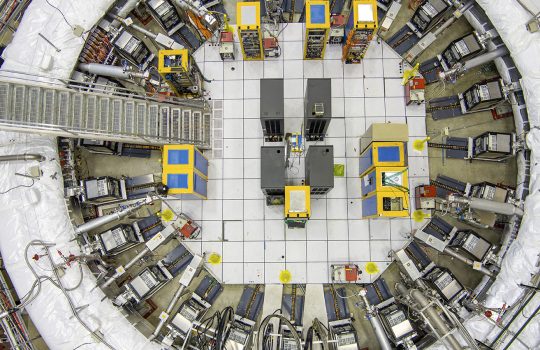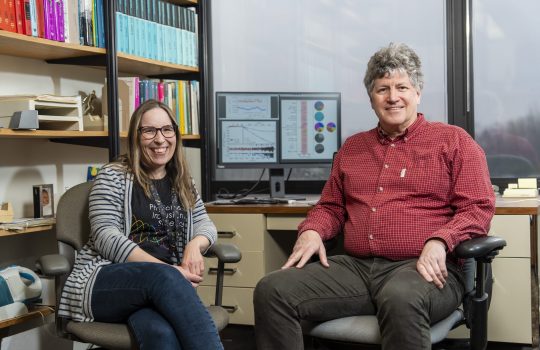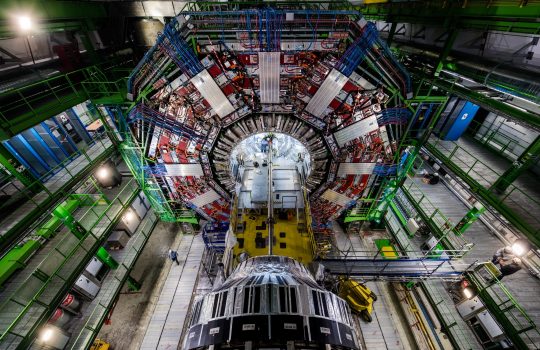Physicists now have a brand-new measurement of a property of the muon called the anomalous magnetic moment that improves the precision of their previous result by a factor of 2.
An international collaboration of scientists working on the Muon g-2 experiment at the U.S. Department of Energy’s Fermi National Accelerator Laboratory announced the much-anticipated updated measurement on Aug. 10. This new value bolsters the first result they announced in April 2021 and sets up a showdown between theory and experiment over 20 years in the making.
“We’re really probing new territory. We’re determining the muon magnetic moment at a better precision than it has ever been seen before,” said Brendan Casey, a senior scientist at Fermilab who has worked on the Muon g-2 experiment since 2008.
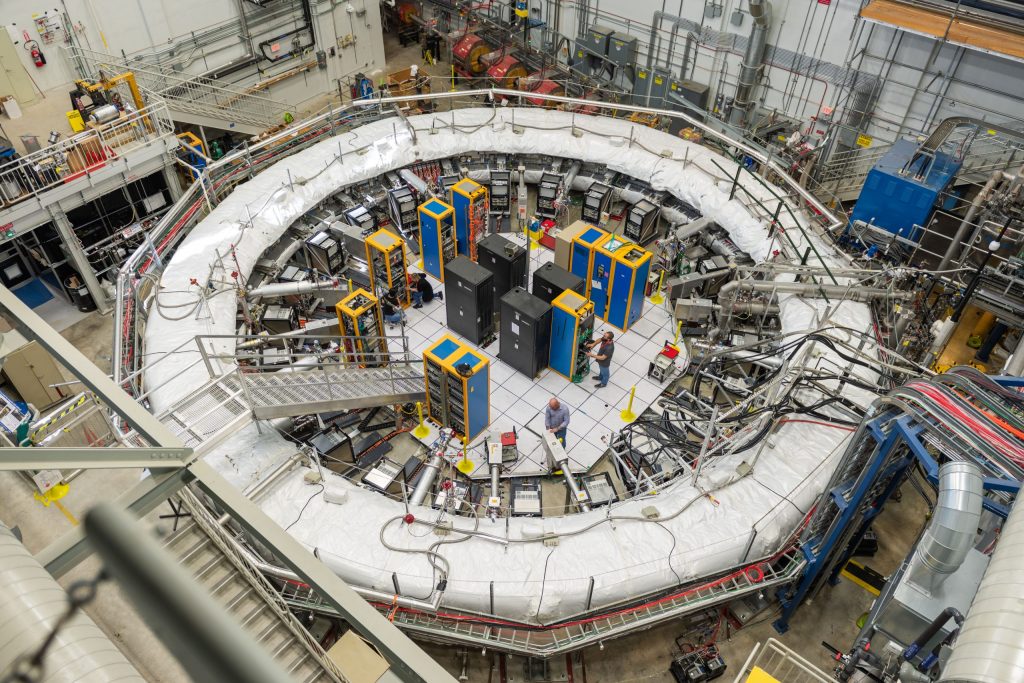
The announcement on Aug. 10, 2023, is the second result from the experiment at Fermilab, which is twice as precise than the first result announced on April 7, 2021. Photo: Ryan Postel, Fermilab
Physicists describe how the universe works at its most fundamental level with a theory known as the Standard Model. By making predictions based on the Standard Model and comparing them to experimental results, physicists can discern whether the theory is complete — or if there is physics beyond the Standard Model.
Muons are fundamental particles that are similar to electrons but about 200 times as massive. Like electrons, muons have a tiny internal magnet that, in the presence of a magnetic field, precesses or wobbles like the axis of a spinning top. The precession speed in a given magnetic field depends on the muon magnetic moment, typically represented by the letter g; at the simplest level, theory predicts that g should equal 2.
The difference of g from 2 — or g minus 2 — can be attributed to the muon’s interactions with particles in a quantum foam that surrounds it. These particles blink in and out of existence and, like subatomic “dance partners,” grab the muon’s “hand” and change the way the muon interacts with the magnetic field. The Standard Model incorporates all known “dance partner” particles and predicts how the quantum foam changes g. But there might be more. Physicists are excited about the possible existence of as-yet-undiscovered particles that contribute to the value of g-2 — and would open the window to exploring new physics.
The new experimental result, based on the first three years of data, announced by the Muon g-2 collaboration is:
g-2 = 0.00233184110 +/- 0.00000000043 (stat.) +/- 0.00000000019 (syst.)
The measurement of g-2 corresponds to a precision of 0.20 parts per million. The Muon g-2 collaboration describes the result in a paper that they submitted today to Physical Review Letters.
With this measurement, the collaboration has already reached their goal of decreasing one particular type of uncertainty: uncertainty caused by experimental imperfections, known as systematic uncertainties.
“This measurement is an incredible experimental achievement,” said Peter Winter, co-spokesperson for the Muon g-2 collaboration. “Getting the systematic uncertainty down to this level is a big deal and is something we didn’t expect to achieve so soon.”
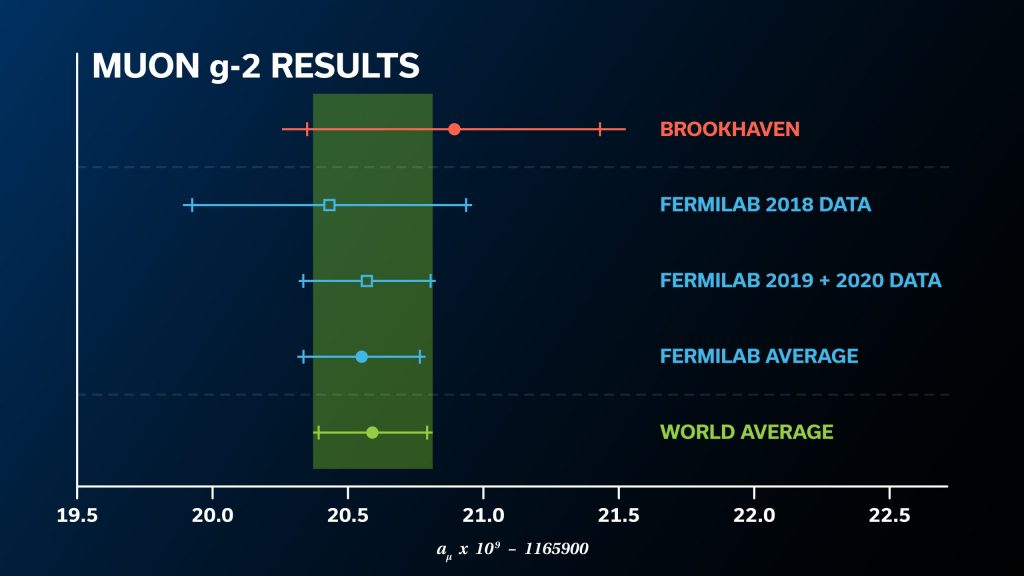
Due to the large amount of additional data that is going into the 2023 analysis announcement, the Muon g-2 collaboration’s latest result is more than twice as precise as the first result announced in 2021. Image: Muon g-2 collaboration
While the total systematic uncertainty has already surpassed the design goal, the larger aspect of uncertainty — statistical uncertainty — is driven by the amount of data analyzed. The result announced today adds an additional two years of data to their first result. The Fermilab experiment will reach its ultimate statistical uncertainty once scientists incorporate all six years of data in their analysis, which the collaboration aims to complete in the next couple of years.
To make the measurement, the Muon g-2 collaboration repeatedly sent a beam of muons into a 50-foot-diameter superconducting magnetic storage ring, where they circulated about 1,000 times at nearly the speed of light. Detectors lining the ring allowed scientists to determine how rapidly the muons were precessing. Physicists must also precisely measure the strength of the magnetic field to then determine the value of g-2.
The Fermilab experiment reused a storage ring originally built for the predecessor Muon g-2 experiment at DOE’s Brookhaven National Laboratory that concluded in 2001. In 2013, the collaboration transported the storage ring 3,200 miles from Long Island, New York, to Batavia, Illinois. Over the next four years, the collaboration assembled the experiment with improved techniques, instrumentation and simulations. The main goal of the Fermilab experiment is to reduce the uncertainty of g-2 by a factor of four compared to the Brookhaven result.
“Our new measurement is very exciting because it takes us well beyond Brookhaven’s sensitivity,” said Graziano Venanzoni, professor at the University of Liverpool affiliated with the Italian National Institute for Nuclear Physics, Pisa, and co-spokesperson of the Muon g-2 experiment at Fermilab.
In addition to the larger data set, this latest g-2 measurement is enhanced by updates to the Fermilab experiment itself. “We improved a lot of things between our first year of taking data and our second and third year,” said Casey, who recently finished his term as co-spokesperson with Venanzoni. “We were constantly making the experiment better.”
The experiment was “really firing on all cylinders” for the final three years of data-taking, which came to an end on July 9, 2023. That’s when the collaboration shut off the muon beam, concluding the experiment after six years of data collection. They reached the goal of collecting a data set that is more than 21 times the size of Brookhaven’s data set.
Physicists can calculate the effects of the known Standard Model “dance partners” on muon g-2 to incredible precision. The calculations consider the electromagnetic, weak nuclear and strong nuclear forces, including photons, electrons, quarks, gluons, neutrinos, W and Z bosons, and the Higgs boson. If the Standard Model is correct, this ultra-precise prediction should match the experimental measurement.
Calculating the Standard Model prediction for muon g-2 is very challenging. In 2020, the Muon g-2 Theory Initiative announced the best Standard Model prediction for muon g-2 available at that time. But a new experimental measurement of the data that feeds into the prediction and a new calculation based on a different theoretical approach — lattice gauge theory — are in tension with the 2020 calculation. Scientists of the Muon g-2 Theory Initiative aim to have a new, improved prediction available in the next couple of years that considers both theoretical approaches.
The Muon g-2 collaboration comprises close to 200 scientists from 33 institutions in seven countries and includes nearly 40 students so far who have received their doctorates based on their work on the experiment. Collaborators will now spend the next couple of years analyzing the final three years of data. “We expect another factor of two in precision when we finish,” said Venanzoni.
The collaboration anticipates releasing their final, most precise measurement of the muon magnetic moment in 2025 — setting up the ultimate showdown between Standard Model theory and experiment. Until then, physicists have a new and improved measurement of muon g-2 that is a significant step toward its final physics goal.
The Muon g-2 collaboration submitted this scientific paper for publication.
This seven-minute video provides additional information about muons and the new result by the Muon g-2 collaboration.
Here is the recording of the scientific seminar held on Aug. 10, 2023.
The Muon g-2 experiment is supported by the Department of Energy (US); National Science Foundation (US); Istituto Nazionale di Fisica Nucleare (Italy); Science and Technology Facilities Council (UK); Royal Society (UK); European Union’s Horizon 2020; National Natural Science Foundation of China; MSIP, NRF and IBS-R017-D1 (Republic of Korea); and German Research Foundation (DFG).
Fermilab is America’s premier national laboratory for particle physics research. A U.S. Department of Energy Office of Science laboratory, Fermilab is located near Chicago, Illinois, and operated under contract by the Fermi Research Alliance LLC. Visit Fermilab’s website at https://www.fnal.gov and follow us on Twitter @Fermilab.
The DOE Office of Science is the single largest supporter of basic research in the physical sciences in the United States and is working to address some of the most pressing challenges of our time. For more information, visit https://science.energy.gov.

